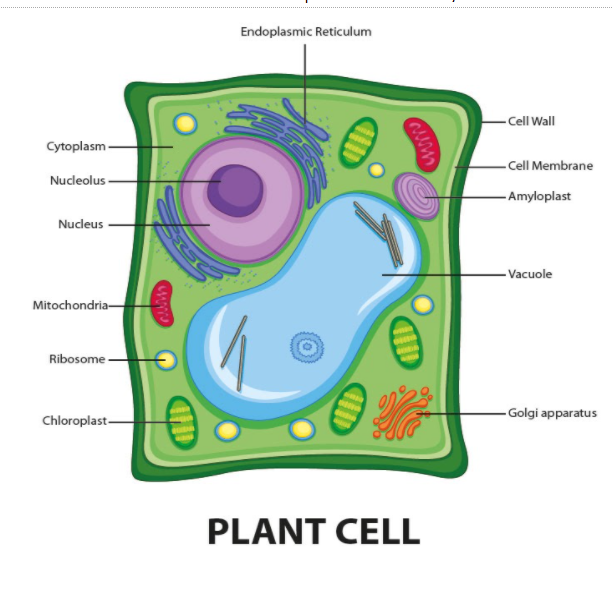Answer
390.6k+ views
Hint: It's a double membrane-bound organelle involved within the synthesis and storage of food, commonly found within the cells of photosynthetic plants. Its genome typically is circular (though linear forms have also been observed) and is roughly 120–200 kilobases long.
Complete answer:
The chloroplast is the characteristic cell organelle only found in photosynthesizing organisms. It contains a pigment called chlorophyll which helps to trap light energy from sunlight and uses water to supply glucose. This characteristic feature of the assembly of glucose isn't found in animal cells. Hence, chloroplast and other specific plastids are not present in animal cells.
Additional Information: Chloroplasts can function as cellular sensors. After detecting stress during a cell, which could flow from to a pathogen, chloroplasts begin producing molecules like 2-hydroxybenzoic acid, jasmonic acid, gas, and reactive oxygen species which may function as defense-signals. As cellular signals, reactive oxygen species are unstable molecules, in order that they probably don't leave the chloroplast, but instead expire their signal to an unknown second messenger molecule. These molecules initiate retrograde signaling—signals from the chloroplast that regulate organic phenomena within the nucleus.
Plastids that contain chlorophyll can perform photosynthesis and are called chloroplasts. Plastids likewise can store items like starch and may synthesize fatty acids and terpenes, which might be utilized for delivering energy and as a staple for the formation of different molecules.
So the correct answer to the above question is ‘False’.

Note: Chloroplasts are distinguished from other sorts of plastids by their green color, which ends up from the presence of two pigments, chlorophyll, and chlorophyll. A function of these pigments is to soak up light energy. In plants, chloroplasts occur altogether green tissues, though they're concentrated particularly within the parenchyma cells of the leaf mesophyll.
Complete answer:
The chloroplast is the characteristic cell organelle only found in photosynthesizing organisms. It contains a pigment called chlorophyll which helps to trap light energy from sunlight and uses water to supply glucose. This characteristic feature of the assembly of glucose isn't found in animal cells. Hence, chloroplast and other specific plastids are not present in animal cells.
Additional Information: Chloroplasts can function as cellular sensors. After detecting stress during a cell, which could flow from to a pathogen, chloroplasts begin producing molecules like 2-hydroxybenzoic acid, jasmonic acid, gas, and reactive oxygen species which may function as defense-signals. As cellular signals, reactive oxygen species are unstable molecules, in order that they probably don't leave the chloroplast, but instead expire their signal to an unknown second messenger molecule. These molecules initiate retrograde signaling—signals from the chloroplast that regulate organic phenomena within the nucleus.
Plastids that contain chlorophyll can perform photosynthesis and are called chloroplasts. Plastids likewise can store items like starch and may synthesize fatty acids and terpenes, which might be utilized for delivering energy and as a staple for the formation of different molecules.
So the correct answer to the above question is ‘False’.

Note: Chloroplasts are distinguished from other sorts of plastids by their green color, which ends up from the presence of two pigments, chlorophyll, and chlorophyll. A function of these pigments is to soak up light energy. In plants, chloroplasts occur altogether green tissues, though they're concentrated particularly within the parenchyma cells of the leaf mesophyll.
Recently Updated Pages
In a flask the weight ratio of CH4g and SO2g at 298 class 11 chemistry CBSE

In a flask colourless N2O4 is in equilibrium with brown class 11 chemistry CBSE

In a first order reaction the concentration of the class 11 chemistry CBSE

In a first order reaction the concentration of the class 11 chemistry CBSE

In a fermentation tank molasses solution is mixed with class 11 chemistry CBSE

In a face centred cubic unit cell what is the volume class 11 chemistry CBSE

Trending doubts
Which are the Top 10 Largest Countries of the World?

Difference Between Plant Cell and Animal Cell

Give 10 examples for herbs , shrubs , climbers , creepers

Fill the blanks with the suitable prepositions 1 The class 9 english CBSE

Difference between Prokaryotic cell and Eukaryotic class 11 biology CBSE

Change the following sentences into negative and interrogative class 10 english CBSE

Write a letter to the principal requesting him to grant class 10 english CBSE

Name 10 Living and Non living things class 9 biology CBSE

Black foot disease is caused by the pollution of groundwater class 12 biology CBSE



